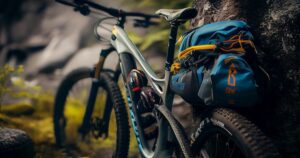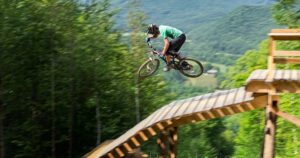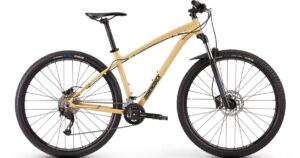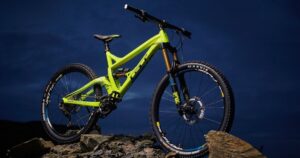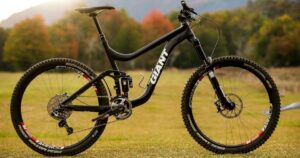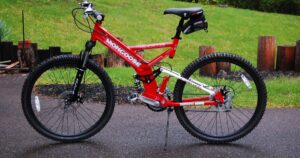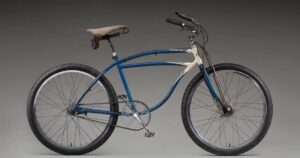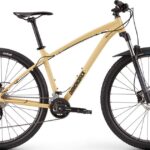A good mountain bike combines durability, agility and comfort. It’s built with sturdy materials to handle rough terrain, has responsive handling for tricky trails and features comfortable components like a well designed saddle and efficient suspension to absorb shocks ensuring an enjoyable ride on challenging landscapes.
Looking for the perfect mountain bike? Unravelling the secret behind “what makes a good mountain bike” is a journey worth embarking on. Discover the key components that transform a bike into your ultimate trail companion. Ready to explore the trails with the perfect ride? Dive into the world of top-notch mountain bikes and find your adventure companion today!
Curious about what sets an exceptional mountain bike apart? Stay with us to uncover the key components that create the ultimate off road companion. From robust frames to responsive gear systems and trail-conquering suspensions explore the elements that define a top tier mountain bike and elevate your riding experience. Keep reading to delve into the world of exceptional biking performance!
Types of Mountain Bikes
- Hardtail Mountain Bikes: These bikes feature front suspension providing a smoother ride on rough terrain while maintaining efficiency for climbs.
- Full-Suspension Mountain Bikes: Equipped with both front and rear suspension these bikes offer enhanced shock absorption ideal for tackling more challenging trails.
- Cross-Country (XC) Mountain Bikes: Designed for speed and efficiency on varied terrain these bikes are lightweight and agile perfect for long rides and racing.
- Downhill Mountain Bikes: Built for steep descents and extreme trails these bikes boast heavy duty suspension and robust frames for maximum control and stability at high speeds.
Frame Materials
Shift gears on a Huffy mountain bike to experience versatile riding across terrains. Mountain bikes come in various frame materials, each influencing the ride differently. Aluminium frames, like those on a Huffy bike offer a lightweight and affordable option perfect for versatile rides. Steel frames on the other hand, provide durability and a smooth ride, ideal for absorbing vibrations on rough trails.

For those seeking high performance, carbon fibre frames offer unparalleled strength and agility though they often come with a higher price tag. Understanding these frame materials can help riders choose the perfect mountain bike tailored to their specific needs and preferences.
Suspension Systems
Suspension systems in mountain bikes play a vital role in absorbing rough terrain enhancing control and ensuring a smoother ride. These systems vary from front suspension (forks) to full suspension (both front and rear) each tailored to different trail demands.
By minimizing impact they maximize comfort and traction allowing riders to tackle diverse landscapes with confidence. The right suspension system can significantly elevate your biking experience offering the stability and agility needed to navigate unpredictable off road paths.
Gearing and Drivetrain
Certainly, here’s a simple table outlining key components of the gearing and drivetrain system in mountain bikes:
| Component | Description |
| Gears | Multiple gear options for varying terrains and slopes |
| Chain | Transfers power from pedals to the drivetrain |
| Derailleurs | Mechanism that shifts the chain between gears |
| Cassette | Cluster of gears attached to the rear wheel hub |
| Crankset | Houses the chainrings that connect to the pedals |
| Chainrings | Front gears providing different gear ratios |
| Shifters | Controls for changing gears |
| Chain Tensioner | Ensures proper chain tension during gear shifts |
| Pedals | Where the rider applies force to power the bike |
These components work in harmony to provide riders with a range of gearing options, facilitating smooth transitions between different terrains encountered while mountain biking.
Handlebars and Grips
- Control and Stability: Proper handlebars and grips offer a firm hold enhancing control over your bike especially on challenging terrain.
- Reduced Fatigue: Ergonomic designs minimise hand strain and fatigue during long rides allowing for a more comfortable and extended biking experience.
- Customizable Comfort: Various grip designs cater to different hand sizes and preferences, ensuring a personalised and comfortable fit for riders.
- Vibration Dampening: Quality grips absorb shocks and vibrations from rough trails reducing discomfort and improving overall handling.
- Improved Handling: Different handlebar shapes and widths influence steering responsiveness, facilitating better manoeuvrability on diverse trails.
- Enhanced Safety: A secure grip minimises the risk of slipping promoting better bike handling and reducing the chance of accidents.
- Better Performance: Optimal handlebar and grip setups contribute to a rider’s confidence allowing for enhanced performance and enjoyment on varied terrains.
Saddle and Seat post
The saddle and seat post in mountain bikes play a crucial role in ensuring comfort and control during rides. The saddle, where the rider sits, needs to strike a balance between cushioning and support, tailored to individual preferences.

Meanwhile the seatpost’s adjustability allows riders to fine tune their position for optimum pedalling efficiency and comfort on varied terrains. Together these components significantly impact a rider’s experience making them essential considerations for any mountain biking enthusiast seeking a smooth and enjoyable journey.
Pedals and Cleats
Pedals and cleats on mountain bikes offer a dynamic connection between rider and machine. These specialised pedals, often paired with compatible cleats on cycling shoes, provide enhanced control and efficiency while navigating challenging terrains.
They enable riders to transmit power more effectively, ensuring a secure grip even on bumpy trails. With adjustable tension and various styles available, pedals and cleats tailor the riding experience to individual preferences, offering stability and confidence through every twist and turn of the trail.
Tire Selection
When it comes to mountain bikes, tire selection holds paramount importance. The right tires can make or break your off-road experience. They come in various widths, treads, and compounds, each tailored to specific terrains and riding styles.
For instance, wider tires offer more stability and traction on rugged trails, while narrower ones excel on smoother surfaces, enabling faster speeds. The tread pattern dictates grip: aggressive patterns for muddy trails and smoother ones for hard packed dirt or rocky paths.
The tire compound, ranging from soft to hard, determines durability and grip levels, crucial for navigating challenging landscapes.Selecting the ideal tires for your mountain bike demands a keen understanding of the terrain you’ll tackle and your riding preferences.
Experimenting with different tire widths, treads, and compounds allows you to fine tune your bike’s performance, enhancing your control, speed, and overall enjoyment on the trails. Understanding the nuances of tire selection empowers riders to optimise their mountain biking experience, conquering diverse terrains with confidence and precision.
Bike Fit and Sizing
| Aspect | Description |
| Frame Size | Determined by height and inseam length; ensures comfortable riding posture and proper reach. |
| Saddle Position | Adjusting saddle height and tilt for optimal comfort, preventing strain and enhancing pedalling efficiency. |
| Handlebar Width | Matching handlebar width to shoulder width provides better control and manoeuvrability. |
| Stem Length | Determines bike handling; longer stems offer stability, while shorter ones enhance agility. |
| Crank Arm Length | Correct length reduces strain on knees and improves pedalling efficiency based on leg length. |
| Suspension Setup | Adjusting suspension settings to match rider weight and trail conditions for a smoother ride. |
| Reach and Stack | Balance between comfort and performance by adjusting reach (horizontal) and stack (vertical) measurements. |
Maintenance Tips
- Enhanced Performance: Regular maintenance boosts your bike’s performance, ensuring smooth rides on any trail.
- Extended Lifespan: Proper care preserves your bike’s components, lengthening its lifespan for years of adventure.
- Safety Assurance: Regular checks prevent unexpected breakdowns keeping you safe during your rides.
- Cost Savings: Maintenance avoids costly repairs by addressing issues before they escalate.
- Optimal Functionality: Well-maintained gears and brakes ensure your bike functions at its best, providing precise control and responsiveness.
- Efficient Rides: Tuned-up parts reduce friction making pedalling easier and your rides more efficient.
- Reliability: Consistent upkeep guarantees a reliable bike ready for any trail or adventure you tackle.
Budget Considerations
When diving into the realm of mountain bikes, considering your budget is crucial. There’s a diverse range available, catering to various price points. Opting for a budget friendly mountain bike doesn’t mean compromising quality entirely.

These bikes often offer decent components and sturdy frames suited for beginners or casual riders exploring trails without breaking the bank. However, it’s essential to balance cost with long-term durability and performance.
Sometimes investing a bit more upfront can lead to a bike that lasts longer and performs better on rough terrains. Understanding your needs and finding that sweet spot between price and quality is key when navigating the world of budget considerations for mountain bikes.
Brand Reputation
Brand reputation in mountain bikes is crucial; it’s the mark of trust and quality in the biking world. Established brands build their name on reliability innovation and customer satisfaction.
These companies invest in research durable materials and advanced technology to deliver bikes that meet the diverse needs of riders earning their reputation through consistent excellence. When it comes to brand reputation in mountain bikes, it’s not just about a name it’s a reflection of performance and credibility.
Renowned brands often have extensive warranties, excellent customer service and a community of loyal riders who vouch for their products. Investing in a reputable brand ensures not just a bike but an assurance of quality, reliability and a support network for your biking journey.
Test Riding and Demo Days
| Aspect | Test Riding and Demo Days for Mountain Bikes |
| Purpose | Introduce riders to various bike models and allow them to test performance on different terrains. |
| Experience | Offers firsthand experience, enabling riders to feel bike responsiveness and comfort before purchasing. |
| Variety | Showcases a range of brands, models, and technologies, allowing comparisons to find the ideal fit. |
| Guidance | Often accompanied by experts or representatives who provide insights, tips, and technical information. |
| Location | Typically hosted in designated biking areas or trails, providing real-world testing environments. |
| Community | Fosters a sense of community among riders, encouraging shared experiences and knowledge exchange. |
| Decision-making Aid | Aids in informed decision-making, helping riders choose bikes that align with their riding style and preferences. |
Environmental Impact
- Low Carbon Footprint: Mountain bikes offer eco-friendly transportation emitting zero carbon emissions and reducing reliance on fossil fuels.
- Preservation of Nature: By encouraging outdoor activity, mountain biking promotes appreciation for nature fostering a desire to conserve and protect natural landscapes.
- Minimal Habitat Disruption: Trails designated for mountain biking often follow specific guidelines minimising impact on wildlife habitats and ecosystems.
- Reduced Infrastructure: Unlike motorised vehicles mountain bikes require minimal infrastructure preserving natural areas and reducing the need for road construction.
- Promotion of Conservation Efforts: Mountain biking communities often engage in conservation projects advocating for the preservation of trails and natural environments.
- Healthier Lifestyle: Encouraging biking as an alternative to driving reduces pollution promoting cleaner air and healthier living environments.
- Connection with Nature: Riding through forests and mountains fosters a direct connection with the environment nurturing a sense of responsibility towards its protection.
Trends in Mountain Biking

Mountain biking trends are evolving faster than ever bringing exciting changes to mountain bikes. The latest designs prioritise lightweight yet durable frames enhancing manoeuvrability without compromising strength.
With advancements in suspension technology bikes now offer smoother rides on even the roughest trails amplifying comfort and control for riders of all levels.Additionally electric mountain bikes (eMTBs) have surged in popularity blending pedal power with electric assistance extending the range and accessibility of trails.
Furthermore, there’s a noticeable shift towards eco-conscious materials and sustainable manufacturing practices, even within the realm of Mullet Bike Pros and Cons reflecting a growing commitment to preserving nature while enjoying its rugged beauty. Stay tuned to witness how these trends continue to shape the future of mountain biking and redefine the possibilities of off-road adventures!
Safety Precautions
When hitting the trails on a mountain bike safety precautions are paramount. Always wear a helmet; it’s your best defense against potential head injuries. Ensure your bike is equipped with reliable brakes and properly inflated tires to maintain control on rugged terrain.
Additionally, check your bike’s components regularly, including brakes, gears, and suspension to guarantee they’re in top condition before every ride. Moreover familiarize yourself with trail conditions and choose routes that match your skill level. Don’t forget essential gear like gloves and knee pads for added protection.
Lastly, riding with a buddy whenever possible and informing someone about your biking plans safety is a shared responsibility that ensures a thrilling and secure mountain biking experience.
Frequently Asking Question ( FAQS )
What frame material is best for a mountain bike?
A sturdy aluminium frame is common for durability and affordability, while carbon frames offer lighter weight and enhanced shock absorption.
Are full suspension bikes better than hardtails?
It depends on the terrain. Full suspension bikes excel on rough trails, offering better traction and comfort, while hardtails are efficient on smoother paths and climbs.
What tire size is ideal for mountain biking?
Tire size varies based on terrain and preference. Larger tires (27.5″ or 29″) provide better traction and roll over obstacles easier, while smaller ones (26″) offer agility and manoeuvrability.
What kind of brakes are suitable for mountain bikes?
Disc brakes are prevalent due to their consistent stopping power in various conditions offering better control and reliability on trails.
How many gears should a good mountain bike have?
The number of gears varies, but a wide range (usually 10-12 gears) provides versatility for tackling steep climbs and high speed descents.
Conclusion
In essence deciphering what makes a good mountain bike boils down to a harmonious blend of key components. It’s not just about a single feature but the synergy of elements: robust frames, responsive suspension, reliable brakes and adaptable gears that elevate the biking experience.
Striking the right balance ensures a ride that’s not just about conquering trails but about feeling connected to the terrain beneath your wheels.Ultimately understanding what makes a good mountain bike empowers riders to make informed choices aligning their preferences and riding style with the bike’s capabilities.
It’s a journey of exploration where each trail, each turn reveals a bit more about the perfect combination that caters to individual needs. So whether it’s the thrill of downhill descents or the challenge of uphill climbs a good mountain bike becomes more than a machine; it becomes an extension of the rider’s passion for adventure and the great outdoors.

